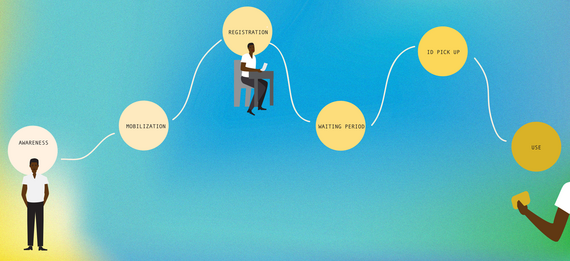UX Design for National Identity
How empathy for some users translates into efficiency for others
1.1 billion people worldwide do not officially exist—and without an entry in a database or a shiny plastic card to prove their identity, they can’t participate at the most basic levels of society.
Imagine moving to a new city, but without an ID card. To get a job, you’ll need to prove who you are. Have a résumé? “How do I really know you are what you say you are?” they say. “Prove it.” Try taking a flight, getting an apartment, or getting a drink if you’re not already grey-haired. Same luck. Without an ID, you are lost.
A legal identity protects access to social services, quality healthcare, education, and other fundamental rights—in fact, identity is a human right. So, what would it take to ensure that all humans can assert their identity? Who would own the data? How would it be used? If a country were to roll out an identity system for the first time, what would the prerequisites for individuals be?
There are so are many human touchpoints in the journey towards safeguarding an identity. At IDEO.org, we believe that putting people at the center of these moments will actually benefit all stakeholders (government, tech companies, legal firms, and NGOs serving them). As part of our ID2020 partnership, we’re pushing ahead for solutions on all of these fronts.
Earlier this year, IDEO.org went to Tanzania to understand the human experience behind mass ID registrations and how people feel about getting an ID for the first time. The team spent time with several stakeholders involved in registration and the folks who would actually be enrolling. We learned that the success or failure of these systems, depends on very real, human considerations, even if the issuing body has limited resources to put towards the rollout’s operation:

Understand barriers in individual journey
Mass registrations focus on operations and numbers; people are often forgotten. For those in the margins, small logistics can turn into big obstacles, especially if they are pregnant, elderly, sick, live far away, or cannot pay for transportation.
Being transparent and listing out the steps and costs involved not only minimizes hardships for the people enrolling, it also maximizes enrollment. Understanding the individual experience can mitigate collective costs.

Design for high-tech with low-tech in mind
For some, the concept of identity is tied to existing low-tech identities, like ink fingerprints and basic cards. At present in Tanzania, the most important element on the national identity card itself is the signature.
Overall, people trust the government to have information on them but may not understand the implications of sharing their information. This is where digital context setting is key. How might we educate folks on information storage and privacy? How will the new technology make someone feel at any given step? Being transparent and candid along the way can make things more efficient for users as well as providers.

Speak to the right values
The underlying value of the NID is both to showcase national pride and prove citizenship to others. However, using patriotism & pride as a tentpole for your communications strategy can encourage discrimination. Instead, focus on the unifying aspects of an ID system and how it will actually empower individuals.
If we want to truly empower people through identification, part of that power is the freedom to choose. Remember the journey you took to understand the complexities of digital identity and make sure that you are bringing the public along in a respectful and inclusive manner. Your users are shareholders.
IDEO.org sees a great opportunity for human-centered design to play a role in the building of digital identity systems and services. These systems will need to be adapted to regional cultures and traditions. Interfaces will need to account for the digital divide inherent in all nations. And communicating process for fair recourse procedures is vital to building trust.
Most importantly, we see that digital identity is only the entry point to a vast ecosystem of services with which it will interact—it will take service designers to build seamless (and empathetic) experiences, communication designers to illustrate the value of the process, and industrial designers to hone the card and card-reading devices. Designing for human potential at every level is at the heart of human-centered design.
We are excited about the future and believe that with an equitable, inclusive, and transparent approach to building it, we can all benefit. As long as we design in the open, there will be no invisible people.